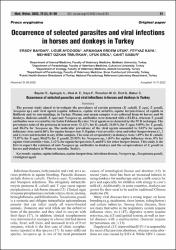Occurrence of selected parasites and viral infections in horses and donkeys in Turkey

Göster/
Erişim
info:eu-repo/semantics/openAccessTarih
2023Yazar
Baydar, ErsoyAydoğdu, Uğur
Utuk, Armağan Erdem
Kaya, Feyyaz
Ti̇murkan, Mehmet Özkan
Erol, Ufuk
Babur, Cahi̇t
Üst veri
Tüm öğe kaydını gösterÖzet
The present study aimed to investigate the prevalence of certain protozoa (B. caballi, T. equi, T. gondii, Neospora sp.) and viral agents (equine influenza, equine viral arteritis, equine herpesviruses) of equids in Balikesir and its surroundings, in Turkey. Plasma and serum samples were collected from 66 horses and 96 donkeys. Babesia caballi, T. equi and Neospora sp. antibodies were detected with c-ELISA, whereas T. gondii antibodies were revealed by the Sabin Feldman Dye test. Viral agents were detected by the PCR technique. The prevalence rates of the protozoa in horses were 12.12% for B. caballi, 34.84% for T. equi, 9.09% for T. gondii, and 10.6% for Neospora sp. The molecular prevalence of the viral agents amounted to 3.03% for equine influenza virus and 6.06% for equine herpesvirus 5. Equine viral arteritis virus and other herpesviruses (1, 2 and 4) were not detected in any of the samples. The rates of seropositivity in donkeys were 1.69% for B. caballi, 71.87% for T. equi, 90.62% for T. gondii, 23.95% for Neospora sp., 1.04% for equine influenza virus, 0% for equine viral arteritis virus, 3.12% for equine herpesvirus 5, and 0% for other herpesviruses. This study is the first to report the existence of anti-Neospora sp. antibodies in donkeys and the seroprevalence of T. gondii in horses and donkeys in Western Anatolia, Turkey.

















